|
|
|
Sort Order |
|
|
|
Items / Page
|
|
|
|
|
|
|
| Srl | Item |
| 1 |
ID:
164126


|
|
|
|
|
| Summary/Abstract |
Often there is a tendency to perceive the journey of Agni ballistic missiles over the years as merely a function of range escalation, the fact, however, is that each successive missile type is related to a particular need and operational logic. This article tries to make sense of this logic by connecting each successive Agni missile to the felt need and technological challenge that prevailed at that point in time.
|
|
|
|
|
|
|
|
|
|
|
|
|
|
|
|
| 2 |
ID:
164116


|
|
|
|
|
| Summary/Abstract |
In the era of intense Trade War between various world powers, use of multinational forces (even without UN sanction), Proxy war by nations using irregulars, use of terrorists supported by militaries, terrorism, information warfare (including perception management, cyber attacks, and use of media including social media), military posturing through military exercises, expansion of military bases, diplomatic pressures and technological threats, there is a need to give a fresh look at the definitions of War, World War, Cold War and analyse if we have already entered the Third World War or otherwise. It may well happen that because of mutually destructive capabilities of a large number of powers, the full scale, declared World War like First or Second World Wars between combat forces may not occur, as it will be economically devastating for all major powers, as none of them can afford it. The military hardware (including nuclear weapons) however will continue to grow as an instrument for deterrence, as well as trade.
|
|
|
|
|
|
|
|
|
|
|
|
|
|
|
|
| 3 |
ID:
164125
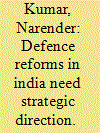

|
|
|
|
|
| Summary/Abstract |
Is there a clarity about what exactly is required from the Armed Forces in a changing regional and global security environment when national interests are spread across the continent? Big question is that, have we developed capabilities to secure India’s interests that are so varied and dispersed strategically and geographically? If India has to break out of the claustrophobic confines of South Asia, it needs certain capabilities that can propel it to be a net security provider at least in Northern Indian Ocean Region.1 However, the defence reforms or absence of these tells a different story; that India may desire to be there but the capabilities are not commensurate with the desired mandate. The Government of India has appointed the Defence Planning Committee (DPC) that would be a permanent body mandated to prepare a draft national security strategy, undertake a strategic defence review, and formulate an international defence engagement strategy.2 It will be premature to pass the judgement on DPC but a doubt remains that is it duplication and add-on to the existing cumbersome national security structure? Appointment of DPC should not be confused with the defence reforms as these are two different aspects.
|
|
|
|
|
|
|
|
|
|
|
|
|
|
|
|
| 4 |
ID:
164128
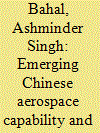

|
|
|
|
|
| Summary/Abstract |
The Ninth Century Chinese alchemists discovered black powder while searching for the elixir of life. this accidental discovery led to experiments for weapons such as bombs, cannon, incendiary arrows and rocket-propelled fire arrows.1 The Chinese were the first to develop a rocket around 1212 AD and used them in a war with Mongols. During the battle of Kai-Keng, they used “arrows of flying fire”. This arrow was a simple form of a solid-propellant rocket.2 From development of simple rockets to anti-satellite weapons, China has progressed rapidly in its aerospace offensive capabilities and the anti-satellite test carried out by China in Jan 2007 demonstrated that the development of anti-satellite (ASAT) technologies created an environment in which civil and military satellites increasingly came under the risk of attack. In response, Dr. Saraswat stated that India had “all the building blocks necessary” for an anti-satellite weapon. The propulsion module and kill vehicle existed in principle; the weapon could be developed in totality soon.3 Yet, the moot question is whether India is ready to face the rapid Chinese modernization onslaught?
|
|
|
|
|
|
|
|
|
|
|
|
|
|
|
|
| 5 |
ID:
164121
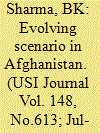

|
|
|
|
|
| Summary/Abstract |
From the dawn of history Afghanistan has remained at the centre–stage of peace and conflict in the Indian subcontinent. The ‘Old Silk Route’ formed the crucible of trade, science, spirituality and cross-fertilisation of civilisations, connecting the Indian sub-continent-Central Asia-West Asia and China. On the flip side, many invasions; notably led by Alexander, Tamerlane, Ghauri, Ghaznvi, Babur, staged through Afghanistan into India thus redrawing the sociopolitical landscape of the region. Afghanistan was the fulcrum of the first Great Game of the 19th Century between the British India and the Russian empire. The two great powers realised the futility of subjugating Afghanistan and settled for creating it as a buffer state. The 2nd Great Game in the Eighties (1979-1989) between the US – Saudi Arabia – Pakistan alliance against the Soviet Union legitimised the use of Islamist Jihad as an instrument of state policy. Post the US exit, the Af – Pak region emerged as the epicentre of international terrorism. In the fall of eighties, Pakistan military establishment directed Afghan trained Jihadists to wage a proxy war in Kashmir. The 3rd Great Game began in the wake of 9/11 which saw the ouster of Taliban regime and onset of democracy in Afghanistan, albeit in the middle of a virulent conflict unleashed by Pakistan sponsored Taliban and hosts of other militant groups, including Islamic State of Khorasan Province (ISKP). Talibanistan of Afghanistan or spread of rabid Wahabi – Salafi ideology does not bode well for regional peace and stability.
|
|
|
|
|
|
|
|
|
|
|
|
|
|
|
|
| 6 |
ID:
164118


|
|
|
|
|
| Summary/Abstract |
Adecade back Asia-Pacific and South Asia defined two separate regions. The growth of India and its relevance to Asia-Pacific was perhaps first recognised by the Japanese Prime Minister Abe when speaking at the Indian Parliament in August 2007. He said, “My friends, where exactly do we now stand historically and geographically? To answer this question, I would like to quote here the title of a book authored by the Mughal prince Dara Shikoh in 1655. We are now at a point at which the Confluence of the Two Seas is coming into being. The Pacific and the Indian Oceans are now bringing about a dynamic coupling as seas of freedom and of prosperity. A “broader Asia” that broke away geographical boundaries is now beginning to take on a distinct form. Our two countries have the ability and the responsibility to ensure that it broadens yet further and to nurture and enrich these seas to become seas of clearest transparence.”
|
|
|
|
|
|
|
|
|
|
|
|
|
|
|
|
| 7 |
ID:
164129


|
|
|
|
|
| Summary/Abstract |
During my visit to Leh in 2017, I saw Ladakh Marathon banners all over the city screaming – “For the Resilient and the Brave”. Having already run over a dozen half marathons (21.097 kms for the uninitiated) in Delhi, I was still skeptical, looking longingly at the banners, if I would ever be brave and resilient enough to run this one – the highest and amongst the toughest marathons in the world in climate that tests the limits of human endurance.
|
|
|
|
|
|
|
|
|
|
|
|
|
|
|
|
| 8 |
ID:
164123


|
|
|
|
|
| Summary/Abstract |
The recent elections in Pakistan, with Imran Khan installed as Prime Minister, is in the backdrop of increased internal strife, a looming economic crisis that may force Pakistan seek bailout package from the IMF for the 13th time, continuing insurgency in Balochistan, public realisation of China’s looming debt trap and discontent over lack of governance. With the Pakistani military directly and indirectly ruling for 30 and 40 years respectively of Pakistan history, questions arise whether Imran Khan really wants peace given his own radical background, what freedom of action will he be permitted by the military and will détente be temporary till Pakistan tides over the immediate economic crisis?
|
|
|
|
|
|
|
|
|
|
|
|
|
|
|
|
| 9 |
ID:
164122
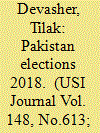

|
|
|
|
|
| Summary/Abstract |
The past 22 years have been quite a journey for the 22nd Prime Minister of Pakistan, Imran Khan and his Pakistan Tehreek-i-Insaf (PTI). In 2002, the PTI had one seat (that of Imran Khan himself) in the National Assembly (NA); it boycotted the 2008 elections; in 2013 it had around 30 seats. Now it has 116 general seats. In the process, its vote bank increased from 1,60,686 votes in the 2002 elections to 7.6 million in 2013 and 16.8 million in 2018 (approximately 31.87 per cent of the votes), an increase of over 100 per cent. With the joining of nine independents and allocation of 28 reserved seats for women and five for minorities, its tally has gone up to 158. However, after vacating six seats that were won by its candidates in more than one constituency its net tally, till by-elections are held, would be 152. It has thus, become the largest national party at the Centre.
|
|
|
|
|
|
|
|
|
|
|
|
|
|
|
|
| 10 |
ID:
164127
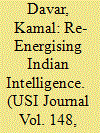

|
|
|
|
|
| Summary/Abstract |
Since time immemorial, the art and science of Intelligence remains an irreplaceable and a central constituent of statecraft. Unquestionably, it is also the first line of defence for a nation and if prudently utilised, a veritable force-multiplier. Among most nations, whenever a security catastrophe, a cataclysmic event or even a major geopolitical setback occurs, opprobrium is heaped on its intelligence set-ups even though such failures could be attributable, among other factors, to systemic shortcomings, faulty analyses, sheer negligence and/or leadership failures within the nation. Though lapses in intelligence acquisition and analyses may result in glaring security shortfalls and grave national embarrassment, on the other hand intelligence successes, normally, cannot be publicly acknowledged as “the practitioners of the art of intelligence have to be silent warriors for there is no place for drum-beating in the business of Intelligence.”
|
|
|
|
|
|
|
|
|
|
|
|
|
|
|
|
| 11 |
ID:
164119


|
|
|
|
|
| Summary/Abstract |
Iam deeply honoured to be invited to deliver the 22nd Colonel Pyara Lal Memorial Lecture. The topic chosen for the lecture is of considerable current interest, which is why I value the opportunity given to me to share my thoughts on the subject. I would like to clear some conceptual points, have a broad look at how some major powers and some in our neighbourhood use the military arm of their diplomacy to further their national interest, the reason why there is debate in India about our insufficient use of the military instrument in our foreign policy, the limitations we have in this regard, the evolution of our attitude towards a military role in our diplomacy and, finally, how the overall picture is much more nuanced than what may be commonly believed.
|
|
|
|
|
|
|
|
|
|
|
|
|
|
|
|
| 12 |
ID:
164117


|
|
|
|
|
| Summary/Abstract |
Anew strategic dynamic between the United States (US), China and Russia in contemporary international affairs has emerged over the past few years. The process began more than five years ago with the US applying new domestic laws extra-territorially to impose sanctions against Russia (on account of alleged corrupt practices) and Crimea. The emergence of a new assertive China under President Xi Jinping catalysed this process further.1 With the election of President Donald Trump in the US presidential elections in 20162, the strategic dynamic between the three powers has been marked by disruptions in their interaction. This has resulted in a gridlock in international relations, with each of the three powers acting within their individual strategic frameworks to derive advantage over the other. Inevitably, this interaction has major ramifications for the system of international relations founded on the principle of international cooperation established almost a century ago after the First World War. To assess this complex interplay, it would be useful to look at the strategic drivers of the bilateral equations between the US and Russia, the US and China, and China and Russia.
|
|
|
|
|
|
|
|
|
|
|
|
|
|
|
|
| 13 |
ID:
164124
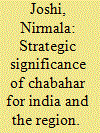

|
|
|
|
|
| Summary/Abstract |
As the globalising trend of the twenty first century gained a new momentum with trade and commerce and economic engagement among nations, the issue of connectivity projects also moved to the centre stage of international politics. What gave a further stimulus to connectivity projects was the opening of the vast Eurasian landmass after the break-up of the Soviet Union in 1991. The Eurasian space is extremely rich in natural resources and vital minerals, but the Eurasian landmass is landlocked. Eurasian region’s landlocked status spurred the construction of overland transport corridors in order to secure and if possible, to control the natural resources. The opening of this region also resulted in the reinvention of the British geographer Halford Mackinder’s theory of “Heartland of Eurasia” and the “Pivot of History”. In the process the world witnessed an evolving interplay of economics and geopolitics in Eurasia both by the developed and developing countries. In this context the connectivity issue acquired immense significance. It was one of the key issues on the agenda of those powers involved in Eurasia.
|
|
|
|
|
|
|
|
|
|
|
|
|
|
|
|
| 14 |
ID:
164120
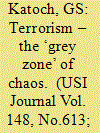

|
|
|
|
|
| Summary/Abstract |
The requirement of having some rules and laws under which war should be conducted emerged consequent to the Geneva Convention of 1864 which was basically about the “Amelioration of the Condition of the Wounded and Sick in Armed Forces in the Field”. It was only in the 1899 Hague Conference that codification of the laws of war on land, as the “Hague Conventions 1899” was undertaken. The wars post that convention used the rules that emerged, to interpret the “Jus in Bello” concept or the “Just way to wage war”. While these were infringed many times, however, the laws did rein in truant states and permitted trials of war criminals. In a short period of less than a century since the laws emerged, countries and organisations had learnt to circumvent the rules in the form of proxy wars and terrorism. In this milieu conflict is waged in a zone where the rules can be twisted and misinterpreted or waged in a manner that neither do they follow the law, nor (legally) do they infringe it. Conflict is no longer black or white, it is opaque, it is in the “Grey Zone”.
|
|
|
|
|
|
|
|
|
|
|
|
|
|
|
|
|
|
|
|
|